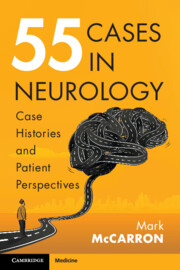Book contents
- 55 Cases in Neurology
- 55 Cases in Neurology
- Copyright page
- Contents
- Preface
- Acknowledgements
- Section 1 Visual Disturbance
- Section 2 Headache and Pain
- Section 3 Weakness
- Case 19 Bleeding Brain
- Case 20 A Battery Issue
- Case 21 Symptoms Took Years to Develop
- Case 22 High-Frequency Improvement
- Case 23 Singling Out Dermatomes
- Case 24 Asthmatic Neurology
- Case 25 Neurological Consequences of Infection
- Case 26 When Speech and Swallow Fail
- Case 27 Recurrent Weakness
- Case 28 Increasing Golfing Handicap
- Section 4 Behavioural and Language Changes
- Section 5 Confusion
- Section 6 Movement Disturbances
- Section 7 Acute Onset of Neurological Symptoms
- Index
- Plate Section (PDF Only)
- References
Case 28 - Increasing Golfing Handicap
from Section 3 - Weakness
Published online by Cambridge University Press: 27 July 2023
- 55 Cases in Neurology
- 55 Cases in Neurology
- Copyright page
- Contents
- Preface
- Acknowledgements
- Section 1 Visual Disturbance
- Section 2 Headache and Pain
- Section 3 Weakness
- Case 19 Bleeding Brain
- Case 20 A Battery Issue
- Case 21 Symptoms Took Years to Develop
- Case 22 High-Frequency Improvement
- Case 23 Singling Out Dermatomes
- Case 24 Asthmatic Neurology
- Case 25 Neurological Consequences of Infection
- Case 26 When Speech and Swallow Fail
- Case 27 Recurrent Weakness
- Case 28 Increasing Golfing Handicap
- Section 4 Behavioural and Language Changes
- Section 5 Confusion
- Section 6 Movement Disturbances
- Section 7 Acute Onset of Neurological Symptoms
- Index
- Plate Section (PDF Only)
- References
Summary
A 70-year-old right-handed man with a history of stable ocular myasthenia gravis presented with progressive pins and needles in his hands, progressing to numbness over a few months. He described an inability to hold a golf club. He said that if he put a hand into a bag, he would not be sure without visual help if he would take out the intended object. His legs had also started to feel weak. On moving in a certain way, he experienced a stinging electrical shock feeling throughout his body. In the few weeks before a neurological consultation, his right foot had become weak. He also developed bladder urgency but had no problem with his bowels.
- Type
- Chapter
- Information
- 55 Cases in NeurologyCase Histories and Patient Perspectives, pp. 193 - 198Publisher: Cambridge University PressPrint publication year: 2023



